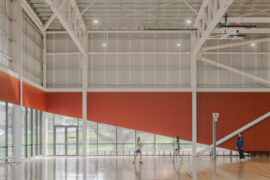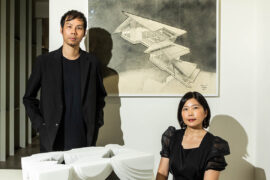When education buildings are properly integrated into the urban fabric of cities, magic happens. Grimshaw puts the method around that magic.

Monash University’s Woodside Building for Technology and Design
November 2nd, 2021
Something magical happens when education buildings are properly integrated into the urban fabric of cities. When this happens, cities grow and flourish from having students and research in their bones, and the universities become sites of meaningful action and vitality informing public debate and aligning research agendas with the needs of the community. This reflects research by Ed Glaeser and others who argue that knowledge spillover is a key outcome, and generator, of urban agglomeration – the economic benefit of density and proximity. Others like Richard Sennett have long argued that civic life is only enabled by particular kinds of public place. A point that can’t be overlooked in our age of demagoguery and pandemics.
However, it’s easy to get it all wrong. Urban university buildings often lose the cloistered character that protects and encourages reflection and open thought, they get the scale wrong and don’t register on the public mind or become too singularly focused on a specific training or discipline, becoming mono-functional and lacking in spatial diversity.
In Australia and globally Grimshaw has spent the last decade developing a methodology for education urbanism. Late last year Grimshaw was named Higher Education Architect of the Year at the Architect of the Year Awards 2020. Five key insights have been developed to ensure the generation of powerful research, social and civic outcomes for education buildings in cities:
Firstly, whether in the heart of the city or further out university buildings should be impactful. The digital revolution has removed historical keystones of banks, post-offices, but there remains a huge role for excellence in architecture through libraries, civic buildings, and our precious universities. This isn’t about branding, but about these critical institutions taking their place in the public eye as key pillars of knowledge, discussion and debate. Scale also builds efficiency into building systems and locks in ambitious approaches.

Monash University’s Woodside Building for Technology and Design
Secondly, this public presence means the buildings demonstrate the claims and research being undertaken within the institution; to illustrate knowledge recursively as something both studied and supported, in theory and practice. Buildings can be performative in a measurable way and as something on display to the public.
Grimshaw led the first phase master planning of a $2 billion investment by the University of Melbourne at Fisherman’s bend just west of central Melbourne. A key element of Australia’s largest urban regeneration project the new engineering building will research and demonstrate world-leading sustainable innovations. By revealing the hidden and messy ‘backstage’ of innovation the universities work is framed and exhibited to the broader public.
Thirdly, research works best when it is clearly defined, open, and inter-disciplinary. Our big problems require solutions that emerge from tackling something from multiple, sometimes contradictory, perspectives; education buildings need to facilitate this
The University of New South Wales Australia’s School of Materials Science and Engineering and School of Chemical Engineering combines key science disciplines in one building. The scheme provides seamless links between physical and chemical science laboratories and working spaces for researchers, academics and faculty members so they can collaborate on key research projects. A high-performance facade demonstrates material design at work and creates a striking public image.
Fourth, a commitment to spatially integrating teaching and research within the buildings is needed. Through a perverse managerialism, teaching has become entirely distinct from research in most modern universities, and careful architectural moves are required to re-fuse these critical and self-supporting practices.
Monash University’s Woodside Building for Technology and Design is certified Passivhaus, zero-carbon ready, high-tech demonstration of this principle. Large spanning steel frames support the interdisciplinary, public research and learning while world-class teaching and research facilities overlap and support each other.
The careful arrangement of research and teaching spaces also improves shared areas and the public realm. High levels of amenity and visible infrastructure create socially attractive interior space while sunlight and shade bring the newly created adjacent streets and avenues to life.

Monash University’s Woodside Building for Technology and Design
Lastly, institutions survive when they adapt and flourish when they are flexible. In short time frames, adaptability enables events and programmatic flexibility for both research and public activity. Longer adaptations respond to unpredictable but inevitable cultural and technological changes.
Building 20 at MIT is a famous example of low-tech adaptability that led to world-leading innovation. A more high-tech example is Grimshaw’s recent repurposing of an original Farrell/Grimshaw 1970s Herman Miller factory project into the Bath Spa University Schools of Art and Design. The original brief was for a building that would adapt to changing needs of current and future occupiers, encouraging an open community for people within and those around it. The re-purposing maintains the original ethos whilst enhancing the environment within, dramatically improving the energy performance and safeguarding the building’s future. The head of the Art School Dan Allen writes: “In the past, we had to adapt our practices to suit the building, but now we have a building that doesn’t dictate but informs how we teach differently. It’s very exciting for the academics.”
Collectively these insights and associated projects evidence an important lesson of all architecture – what goes on inside a building, the way it enables and supports certain kinds of positive overflows – cannot meaningfully be separated from the impact it has on the communities and public places around it.
Grimshaw
grimshaw.global
This article was written by Andrew Cortese and Alison Potter for Indesign Magazine #84. Subscribe now.
INDESIGN is on instagram
Follow @indesignlive
A searchable and comprehensive guide for specifying leading products and their suppliers
Keep up to date with the latest and greatest from our industry BFF's!

A longstanding partnership turns a historic city into a hub for emerging talent

As French-Lebanese Architect Lina Ghotmeh prepares for lectures in Melbourne and Sydney, we hear about the philosophy shaping her internationally celebrated practice.

Joan Montgomery Centre PLC by Warren and Mahoney is a tour de force of education design, with high-end facilities including a swimming pool and general athletic amenities.
The internet never sleeps! Here's the stuff you might have missed

A star of the 2025 INDE Awards is Jenchieh Hung + Kulthida Songkittipakdee / HAS design and research, a practice that made quite the impression on the jury and in the awards.

Trent Jansen’s first Sydney solo exhibition in years celebrates the poetry and stories that grow from collaborative making as well as the importance of co-creation.